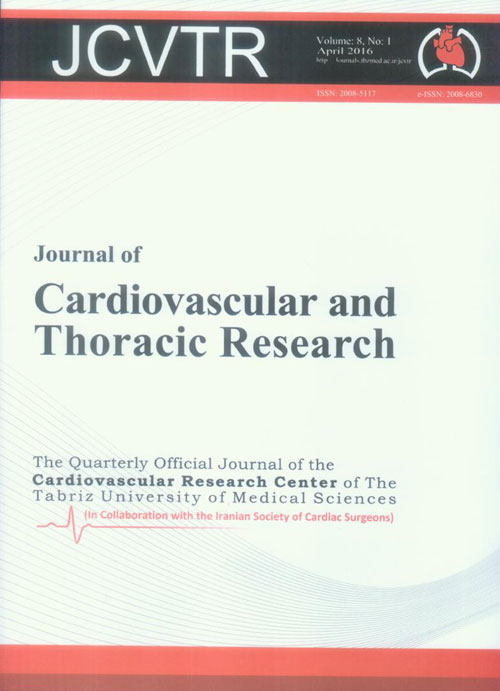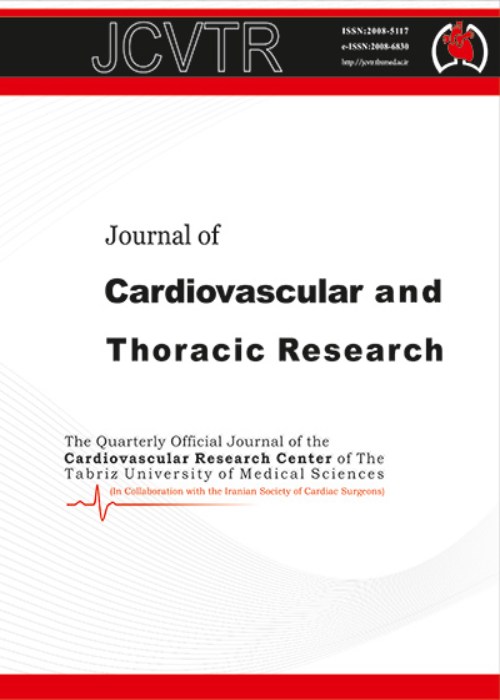فهرست مطالب

Journal of Cardiovascular and Thoracic Research
Volume:8 Issue: 1, Mar 2016
- تاریخ انتشار: 1395/02/07
- تعداد عناوین: 9
-
-
Pages 1-7IntroductionCoronary artery bypass surgery (CABG) is associated with schemia-reperfusion injury and tissue damage. CoQ10 as an antioxidant has an important role and may have cardio- protective effects after myocardial dysfunction and CABG. We aimed to evaluate whether CoQ10 has a myocardial cardio protective impact on cardiac biomarkers after CABG.MethodsIn this double-blind study, 80 patients with coronary artery disease (CAD) who underwent CABG surgery were divided into intervention and control groups and received Q10 supplement or placebo, respectively. The surgical characteristics of the patients in the two groups were similar. The intervention group received 150 mg of Q10 supplement per day for 7 days before the surgery. The control group received placebo capsule. After operation the inter- and intra-group blood levels of CK-MB and troponin, before and after supplementation and 12 hours after the CABG, and postoperative outcomes such as intensive care unit (ICU) stay and hospital stay were compared.ResultsIn this study, 40 subjects were located in each group. The participation rate was 97.5% and men and women accounted for 52.5% and 47.5% respectively. The mean age of the subjects was 58.17 ± 8.55. The two groups were not significantly different in terms of basic variables. Within-group comparison showed a significant increase in the level of troponin enzymes over time (PConclusionQ10 supplementation 7 days before surgery was not effective in reducing CK-MB and troponin after CABG.Keywords: CK, MB, Troponin, Coronary Artery Bypass, CO Q10
-
Pages 8-12IntroductionQuick release bromocriptine (BROM-QR), currently approved for glycemic control, reduces the risk of cardiovascular events in adults with type-2 diabetes mellitus (T2DM). This study evaluates the effect of BROM-QR on homocysteine (HOMC) and high sensitive C-reactive protein (hs-CRP), the biochemical markers of coronary atherosclerosis/inflammation, in patients with uncontrolled T2DM.MethodsIn this non-randomized, before-and-after clinical trial, patients with uncontrolled T2DM on stable doses of two oral hypoglycemic agents received BROM-QR for 6 months. The change in serum concentrations of HOMC was the primary endpoint. Anthropometric measurements such as body mass index (BMI) and waist circumference were measured at the baseline and at the completion of treatment along with fasting plasma glucose (FPG), HbA1c, total cholesterol, triglyceride, creatinine and hs-CRP. Multivariate regression analysis was performed to identify factors associated with changes in the levels of HOMC.ResultsIn 64 patients (46 completed 6 months of treatment), age was 55±7 years and the duration of T2DM was 8.0 ± 4.4 years. On enrollment, mean HbA1c, FPG, hs-CRP and HOMC levels were 9.0± 1.3 percent, 184 ± 42 mg/dL, 3.8± 3.4 mg/dl and 10.8 ± 6.2 micromole/L; respectively. Mean decrease of 0.7 ± 1.1 percent for HbA1c (P = 0.001) and 22 ± 44 mg/dL for FPG was observed (P = 0.002). HOMC levels decreased to 8.5 ± 5.2 micromole/L (P = 0.011) while hs-CRP levels remained unchanged at 3.7 ± 2.9 mg/dL (P = 0.835).ConclusionWhile HOMC and HbA1c levels decreased significantly after 6 months of treatment with BROM-QR in patients with T2DM, serum levels of hs-CRP, total cholesterol and triglyceride did not significantly change.Keywords: Homocysteine, bromocriptine, CRP
-
Pages 13-19IntroductionGenetic variations in the calpain 10 gene (CALPIN-10), single nucleotide polymorphisms-43 (SNP-43), have increased the risk of type 2 diabete mellitus (T2DM) and coronary artery disease (CAD).MethodsWe studied the control and CAD groups for association of association of SNP-43 in the CALPIN-10 gene with T2DM and other risk factors of its complications. Overall, we examined 452 individuals, 224 patients with CAD and 228 healthy subjects for CAD in Iranian population. All the subjects were genotyped for the CALPIN-10, SNP-43 by polymorphism chain reaction (PCR) and restriction fragment length polymorphism (RFLP) methods, using biochemical methods to detect fasting glucose and other biochemical factors in the blood sample. We assessed frequencies of SNP-43 alleles between CAD and normal population groups.ResultsIn CAD patients, the GG allele was significantly associated with T2DM and GG allele was causing high level of glucose. But in control group, there was no relationship between them. Between clinical and biochemical risk factors with different genotypes there was no significant difference in the compared group.ConclusionThe results of our study suggest no significant association between SNP-43 and the risk of T2DM. In other words, CALPIN-10 did not show a major diabetes gene pool capacity in normal southern Iranian population.Keywords: SNP, 43 Polymorphism, CALPIN, 10, Diabete, Coronary Artery Disease, Atherosclerosis, Lipid Profile
-
Pages 20-25IntroductionTo study effects of various sites of right ventricular pacing lead implantation on left ventricular function by 2-dimensional (2D) speckle tracking for radial strain and LV dyssynchrony.MethodsThis was retrospective prospective study. Fifteen patients each with right ventricular (RV) apical (RV apex and apical septum) and non-apical (mid septal and low right ventricular outflow tract [RVOT]) were programmed to obtain 100% ventricular pacing for evaluation by echo. Location and orientation of lead tip was noted and archived by fluoroscopy. Electrocardiography (ECG) was archived and 2D echo radial dyssynchrony was calculated.ResultsThe baseline data was similar between two groups. Intraventricular dyssynchrony was significantly more in apical location as compared to non-apical location (radial dyssynchrony: 108.2 ± 50.2 vs. 50.5 ± 24, PConclusionPacing in non apical location (RV mid septum or low RVOT) is associated with less dyssynchrony by specific measures like 2D radial strain and correlates with better ventricular function in long term.Keywords: Left Ventricle, Artificial Cardiac Pacing, Ventricular Function
-
Pages 26-33IntroductionChronic intermittent hypoxia is considered as a preconditioning status in cardiovascular health to inducing resistance to the low oxygen supply. Diabetic cardiomyopathy leads to inability of the heart to effective circulation of blood preventing of consequent tissue damages so; the aim of this study was elucidation of effect of chronic exposure to hypoxia on Cardiac fibrosis and expression of GLUT4 in experimental diabetic cardiomyopathy.MethodsA total number of 30 rats were randomly divided into three groups; 1: Normoxia control group (NN, n = 10). 2: Normoxia diabetic group (ND, n = 10) that took fat diet for 2 weeks then were injected by streptozotocin (37 mg/kg) and 3: Hypoxia diabetic group (HD, n = 10): that were exposed to chronic intermittent hypoxia (CIH) (altitude ≈3400 m, 14% oxygen for 8 weeks). After hypoxia challenge, plasma metabolic parameters including: fasting blood glucose (FBS), triglyceride (TG) and total cholesterol (TC) were measured by colorimetric assay. Cardiac expression of GLUT4 protein and cardiac collagen accumulation were determined in the excised left ventricle by western blotting, and Masson trichrome staining respectively.ResultsBased on resultant data, FBS, TG and TC were significantly (PConclusionData suggested that CIH might potentiate to improve glucose homeostasis and cardiac tissue structural damages created in type 2 diabetes (T2D).Keywords: Cardiac, Fibrosis, GLUT4, Cardiomyopathy, Altitude
-
Pages 34-39IntroductionThe objective was to examine the role of statins in modulating post-STEMI inflammation and related mortality.MethodsA total of 404 patients with STEMI were reviewed. Demographics, comorbidities, laboratory values, and outcomes were collected. The patients were grouped as STATIN and NOSTAT based on the use of statin drugs at the time of admission. Ninety-seven patients were receiving statin drugs.ResultsThe patients in the STATIN group were more likely to be hypertensive (53.6%), diabetic (37.1%) and to have previous coronary revascularization (9.3%). Following propensity matching of 89 patients in STATIN group to an equal number of patients in NOSTAT controls had lower neutrophil count 7.8 (6.8-8.4) compared to those in the NOSTAT group 9.1 (7.9-10.1). Although there was no difference in-hospital mortality between the two groups, the incidence of pump failure was lower in the STATIN group (5.6% vs. 15.7%; PConclusionStatin treatment prior to STEMI mitigates the cellular inflammatory response after the myocardial infarction, as evidenced by lower leukocyte and neutrophil cell counts in the STATIN group.Keywords: Myocardial Infarction, Statins, Heart Failure, Hyperlipidemia
-
Pages 40-42IntroductionSuccessful closure of atrial septal defect (ASD) improves patients functional class and exercise capacity. In this study we evaluate the safety and feasibility of percutaneous device closure of ASDs.MethodsTwo hundred fifty six patients with significant ASD according to our criteria were enrolled. The patients were treated using nitinol wire mesh transcatheter devices. Complications were followed for a median of 2.5 years.ResultsSuccess rate was 98.4% with 3 unsuccessful cases and a mean hospital stay of 1.007 ± 0.0004 days. Complication rate was 7.42%. Size of the right ventricle (RV) annulus was significantly decreased 24 hours after intervention (P = 0.005).ConclusionThe present report demonstrates that transcatheter closure of ASD is safe and effective.Keywords: Atrial Septal Defect, Transcatheter Closure, Surgical Closure, ASD Devices, Complications
-
Pages 43-45A 29-year old female patient was referred to our hospital for evaluation of dyspnea NYHA class I which begun from several months ago. The only abnormal sign found on physical examination was a grade 2/6 systolic murmur at the apex position without radiation. Echocardiography revealed normal left and right ventricular sizes and systolic function, and only one papillary muscle in left ventricular (LV) cavity which all chordae tendineae inserted into that muscle. The mitral valve orifice was eccentrically located at the lateral side with mild to moderate mitral regurgitation but without significant mitral stenosis. No other congenital heart anomalies were identified. Thus, the final diagnosis was isolated parachute mitral valve (IPMV). She was one of the very rare IPMV cases have ever been reported in adults.Keywords: Isolated Parachute Mitral valve, Shone's Complex, Mitral Stenosis
-
Pages 46-48Pseudoaneurysm of aorta is a rare condition usually seen after aortic surgeries or serious accidents. Here we report a 60 years old man without any previous medical condition who presented with non-specific symptoms and underwent different investigations for more than 1 year, until the presence of a continuous murmur raised suspicion toward his cardiovascular system. In echocardiographic and computed tomography (CT) angiographic studies a large pseudoaneurysm of aortic arch with compression effect on pulmonary artery was detected. At this stage he remembered having suffered a minor trauma 10 years ago. He finally underwent operation and his aortic wall was repaired successfully with a patch. This case highlights the importance of thorough history taking and physical examination in patients irrespective of symptoms and high index of suspicion to detect this life-threatening condition.Keywords: Aortic Arch Pseudoaneurysm, Pulmonary Artery Compression, Blunt Chest Trauma


